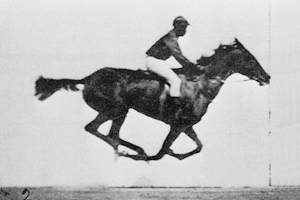Eadweard Muybridge
Eadweard Muybridge (9 April 1830 – 8 May 1904) was an English photographer known for his pioneering work in photographic studies of motion, and early work in motion-picture projection. He adopted the first name Eadweard after the Saxon king and the surname Muybridge, believing it to be similarly ancient and noble. His work has had a significant influence on the development of motion picture technology and the understanding of animal and human locomotion.
Early Life[edit | edit source]
Eadweard Muybridge was born Edward James Muggeridge in Kingston upon Thames, England. He emigrated to the United States in the 1850s, where he changed his name and began a career as a professional photographer, capturing the landscapes and urban life of the American West.
Photographic Work[edit | edit source]
Muybridge's most famous work was the series of photographs of animals in motion, notably horses, which he conducted in the late 1870s at the request of Leland Stanford, the industrialist and former governor of California. Stanford sought to settle a commonly debated question of the day: whether all four feet of a horse were off the ground at the same time during a gallop. Muybridge's experiments, which involved a series of cameras triggered to capture split-second intervals, provided conclusive evidence that horses do indeed lift all four feet off the ground during a gallop.
This work led to the development of the zoopraxiscope, a device for projecting motion pictures that pre-dated the flexible perforated film strip used in cinematography. Muybridge's public demonstrations of the zoopraxiscope are considered some of the earliest instances of moving pictures.
Later Life and Legacy[edit | edit source]
Muybridge returned to England in 1894, where he continued his photographic experiments and published several books on motion, including Animals in Motion (1899) and The Human Figure in Motion (1901). He died in Kingston upon Thames in 1904.
Muybridge's work laid the groundwork for the later development of motion picture technology. His methods of sequential photography and his invention of the zoopraxiscope were significant advancements in the understanding of motion. Today, he is celebrated as a pioneer in the field of photographic studies of motion and motion-picture projection.
Controversies[edit | edit source]
Muybridge's life was not without controversy. In 1874, he was acquitted of the murder of his wife's lover on the grounds of justifiable homicide. This event and the subsequent scandal did not significantly impact his career, as he continued to receive commissions and support from prominent figures of the time.
See Also[edit | edit source]
Search WikiMD
Ad.Tired of being Overweight? Try W8MD's physician weight loss program.
Semaglutide (Ozempic / Wegovy and Tirzepatide (Mounjaro / Zepbound) available.
Advertise on WikiMD
|
WikiMD's Wellness Encyclopedia |
| Let Food Be Thy Medicine Medicine Thy Food - Hippocrates |
Translate this page: - East Asian
中文,
日本,
한국어,
South Asian
हिन्दी,
தமிழ்,
తెలుగు,
Urdu,
ಕನ್ನಡ,
Southeast Asian
Indonesian,
Vietnamese,
Thai,
မြန်မာဘာသာ,
বাংলা
European
español,
Deutsch,
français,
Greek,
português do Brasil,
polski,
română,
русский,
Nederlands,
norsk,
svenska,
suomi,
Italian
Middle Eastern & African
عربى,
Turkish,
Persian,
Hebrew,
Afrikaans,
isiZulu,
Kiswahili,
Other
Bulgarian,
Hungarian,
Czech,
Swedish,
മലയാളം,
मराठी,
ਪੰਜਾਬੀ,
ગુજરાતી,
Portuguese,
Ukrainian
Medical Disclaimer: WikiMD is not a substitute for professional medical advice. The information on WikiMD is provided as an information resource only, may be incorrect, outdated or misleading, and is not to be used or relied on for any diagnostic or treatment purposes. Please consult your health care provider before making any healthcare decisions or for guidance about a specific medical condition. WikiMD expressly disclaims responsibility, and shall have no liability, for any damages, loss, injury, or liability whatsoever suffered as a result of your reliance on the information contained in this site. By visiting this site you agree to the foregoing terms and conditions, which may from time to time be changed or supplemented by WikiMD. If you do not agree to the foregoing terms and conditions, you should not enter or use this site. See full disclaimer.
Credits:Most images are courtesy of Wikimedia commons, and templates, categories Wikipedia, licensed under CC BY SA or similar.
Contributors: Prab R. Tumpati, MD





